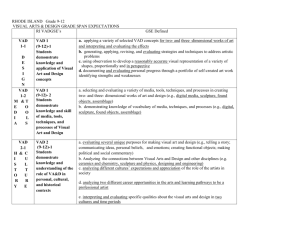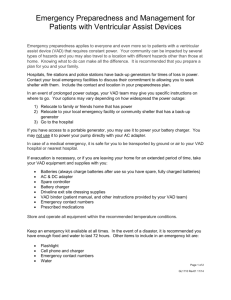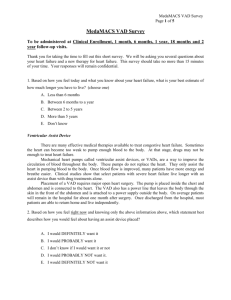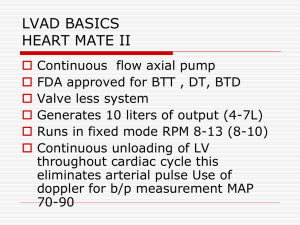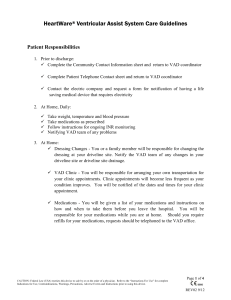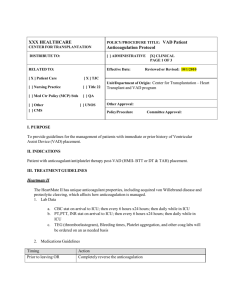About the Rhode Island K-12 Grade Span Expectations in the Arts
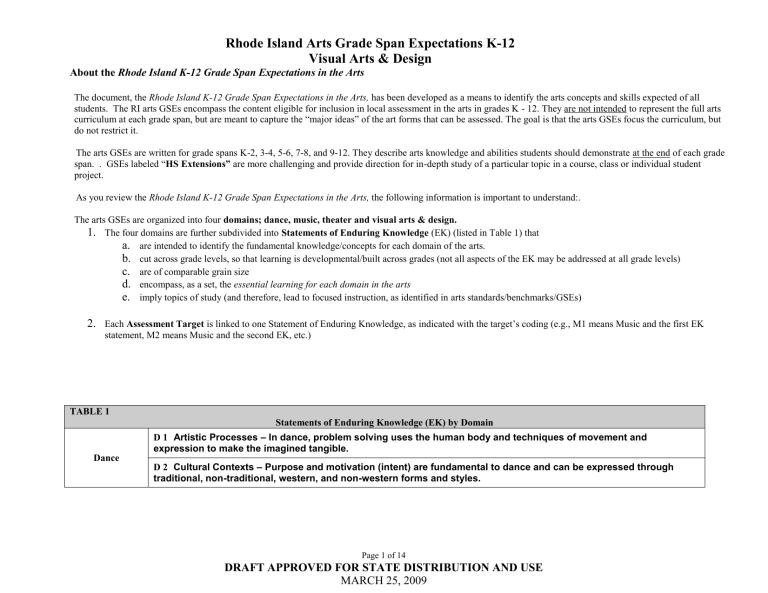
Rhode Island Arts Grade Span Expectations K-12
Visual Arts & Design
About the Rhode Island K-12 Grade Span Expectations in the Arts
The document, the Rhode Island K-12 Grade Span Expectations in the Arts, has been developed as a means to identify the arts concepts and skills expected of all students. The RI arts GSEs encompass the content eligible for inclusion in local assessment in the arts in grades K - 12. They are not intended to represent the full arts curriculum at each grade span, but are meant to capture the “major ideas” of the art forms that can be assessed. The goal is that the arts GSEs focus the curriculum, but do not restrict it.
The arts GSEs are written for grade spans K-2, 3-4, 5-6, 7-8, and 9-12. They describe arts knowledge and abilities students should demonstrate at the end of each grade span. . GSEs labeled “ HS Extensions” are more challenging and provide direction for in-depth study of a particular topic in a course, class or individual student project.
As you review the Rhode Island K-12 Grade Span Expectations in the Arts, the following information is important to understand:.
The arts GSEs are organized into four domains; dance, music, theater and visual arts & design.
1.
The four domains are further subdivided into Statements of Enduring Knowledge (EK) (listed in Table 1) that
a.
are intended to identify the fundamental knowledge/concepts for each domain of the arts.
b.
cut across grade levels, so that learning is developmental/built across grades (not all aspects of the EK may be addressed at all grade levels)
c.
are of comparable grain size
d.
encompass, as a set, the essential learning for each domain in the arts
e.
imply topics of study (and therefore, lead to focused instruction, as identified in arts standards/benchmarks/GSEs)
2.
Each Assessment Target is linked to one Statement of Enduring Knowledge, as indicated with the target’s coding (e.g., M1 means Music and the first EK statement, M2 means Music and the second EK, etc.)
TABLE 1
Dance
Statements of Enduring Knowledge (EK) by Domain
D 1 Artistic Processes – In dance, problem solving uses the human body and techniques of movement and expression to make the imagined tangible.
D 2 Cultural Contexts – Purpose and motivation (intent) are fundamental to dance and can be expressed through traditional, non-traditional, western, and non-western forms and styles.
Page 1 of 14
DRAFT APPROVED FOR STATE DISTRIBUTION AND USE
MARCH 25, 2009
Music
Theater
Visual Arts
Rhode Island Arts Grade Span Expectations K-12
Visual Arts & Design
D 3 Communication – Personal expression and meaning is achieved through the movement of the human body, communicating ideas, values, and emotions
.
D4 Aesthetic Judgment- Knowledge of dance as an art form is used to reflect on and evaluate the work of self and others.
Mu 1 Artistic Processes – The human experience can be created and recreated through sound.
Mu 2 Cultural Contexts – Music connects and expresses history and culture around the globe.
Mu 3 Communication – Music of diverse genres is performed in a variety of settings
.
Mu 4 Aesthetic Judgment- Music knowledge is applied through reflection and evaluation of the music of self and others.
T 1 Artistic Processes – Theater employs creative problem solving using tools, techniques, and technology in one or more disciplines in order to make the imagined tangible.
T 2 Cultural Contexts –Theater arts creatively expresses the values and ideas of human experience, community, and civilization.
T 3 Communication – Theater communicates meaning and expression through the sharing of human experience using image, sound, movement, words, space, time and chronology.
T4 Aesthetic Judgment - Applying knowledge and skills of Theater Arts in order to reflect on and evaluate the work of self and others.
VAD 1 Artistic Processes – Visual Art and Design is the process of creative problem solving using both traditional and innovative media, tools, techniques, and processes in order to make the imagined visible.
VAD 2 Cultural Contexts – Visual Art and Design creatively expresses the values and ideas of human experience, community, and civilization.
VAD 3 Communication – Visual Art and Design is a vehicle for expression and communication through the use and development of metaphor and symbol systems
.
VAD 4 Aesthetic Judgment - Applying knowledge of Visual Art and Design in order to reflect on and evaluate the work of self and others.
Page 2 of 14
DRAFT APPROVED FOR STATE DISTRIBUTION AND USE
MARCH 25, 2009
Rhode Island Arts Grade Span Expectations K-12
Visual Arts & Design
Page 3 of 14
DRAFT APPROVED FOR STATE DISTRIBUTION AND USE
MARCH 25, 2009
Rhode Island Arts Grade Span Expectations K-12
Visual Arts & Design
3.
The Rhode Island K-12 Grade Span Expectations in each of the four Arts domains are sequenced in the following manner:
Domain
Statement of Enduring Knowledge (EK) within the domain
Assessment Target that addresses the EK
Grade Span Expectation that addresses the assessment target
Music Artistic Processes – The human experience can be created and recreated through sound.
Elementary Students chant rhythmic patterns using rhythmic mnemonics (e.g., word chants, rhythm syllables of ta ti-ti or du du-de).
Students echo sing/chant short rhythmic or melodic pentatonic patterns and play short rhythmic or melodic pentatonic patterns on pitched barred instruments.
M1 (K-2)-1
Students show evidence of music literacy
(reading, writing, and understanding of the symbols of sound) by… a. reading, writing, and performing simple rhythmic patterns using iconic or standard notation, including: quarter note/rest, eighth notes (paired), sixteenth-notes, (i.e., four sounds on a beat), half note/rest
M1 (3-4)-1
Students show evidence of music literacy
(reading, writing, and understanding of the symbols of sound) by…
a. reading, writing, and performing rhythmic patterns using standard notation, including: whole note/rest, sixteenth-note patterns, eighth-quartereighth syncopation, dotted quarter-eighth/eighth-dotted quarter, and dotted half note
Middle Level Students demonstrate their ability to sight read music by singing or playing a short, unfamiliar piece of music.
Students create a melodic variation of a familiar melody being performed in class (e.g., compose short variations to an 8-bar melody).
Using music software/technology (e.g., Band-in-a-Box,
Garage Band, Mixcraft, etc.) students create an original arrangement by combining instruments, or changing tempo or style.
M1 (5-6)-1 M1 (7-8)-1
Students show evidence of music literacy
(reading, writing, and understanding of the symbols of sound) by… a. reading, writing, and performing rhythmic patterns using standard notation, including: dotted eighth-sixteenth/sixteenthdotted eighth, three barredeighths, quarter-eighth & eighth-quarter in 6/8, and eight-note triplets
Students show evidence of music literacy
(reading, writing, and understanding of the symbols of sound) by… a. reading, writing, and performing rhythmic patterns using standard notation, including: augmentation and diminution
High School Ensemble students listen and dictate melodies with accurate notation of rhythm and pitch.
Students identify melody, harmony, accompaniment, bass line, and counter melody.
Students improvise original musical ideas (e.g., scat sing, play instruments) on a 12-bar blues form.
M1 (9-12) –1
Students show evidence of music literacy
(reading, writing, and understanding of the symbols of sound) by… a. reading an instrumental or vocal score of up to four staves
M1 (9-12) Ext – 1
Students show evidence of music literacy
(reading, writing, and understanding of the symbols of sound) by… a.
reading a full band, orchestral, or choral score, identifying melody, harmony, accompaniment, bass line, and counter melody
While Statements of Enduring Knowledge are the same across all grade spans, the set of related targets within a grad span do not address all aspects of the EK
Statement. This was done intentionally to focus instruction and assessment on the essential learning for the grade span, as well as on the developmentally appropriate concepts and skills. For example, at the elementary grade span, M1 will focus on chant rhythmic patterns using rhythmic mnemonics, while the middle level grade span will move to demonstrating their ability to sight read music by singing or playing a short, unfamiliar piece of music.
Page 4 of 14
DRAFT APPROVED FOR STATE DISTRIBUTION AND USE
MARCH 25, 2009
Rhode Island Arts Grade Span Expectations K-12
Visual Arts & Design
READING AN ARTS GSE
Statement of Enduring Knowledge
Music 1
Artistic Processes – The human experience can be created and recreated through sound.
Target
Elementary Students chant rhythmic patterns using rhythmic mnemonics (e.g., word chants, rhythm syllables of ta ti-ti or du dude).
EK Grade
Number Span
Target
Number
Stem GSE
M1 (3-4)-1
Students show evidence of music literacy (reading, writing, and understanding of the symbols of sound) by… a. reading, writing, and performing rhythmic patterns using standard notation, including: whole note/rest, sixteenth-note patterns, eighthquarter-eighth syncopation, dotted quarter-eighth/eighth-dotted quarter, and dotted half note
New Content Underlined
Page 5 of 14
DRAFT APPROVED FOR STATE DISTRIBUTION AND USE
MARCH 25, 2009
Rhode Island Arts Grade Span Expectations K-12
Visual Arts & Design
When designing local performance-based Arts Assessments…
Determine which Enduring Knowledge concept and part of the Assessment Target that is to be assessed.
Develop tasks, problems and items with rubrics measuring specific GSEs [e.g., reading, writing, and performing rhythmic patterns using standard notation, including: augmentation and diminution].
Develop tasks, problems and items, for the most part, with an intended cognitive demand ceiling consistent with Depth of
Knowledge (DOK) Levels 2 (Skills and Concepts), 3 (Strategic Thinking), and when appropriate, 4 (Extended Thinking)
Consider your district’s sufficiency requirements as you develop series of assessments, so that students will have enough opportunities to successfully demonstrate reaching the standards in order to become proficient in the arts.
Page 6 of 14
DRAFT APPROVED FOR STATE DISTRIBUTION AND USE
MARCH 25, 2009
Rhode Island Arts Grade Span Expectations K-12
Visual Arts & Design
Visual Arts and Design Enduring Understanding 1
Creative Processes – Visual Art and Design is the process of creative problem solving using both traditional and innovative media, tools, techniques, and processes in order to make the imagined visible.
Elementary Assessment Targets
Students formulate ideas for creating their own works of art and design using brainstorming strategies, sketching, and journaling; use a variety of media, techniques, and processes to express thoughts, feelings, and ideas; and apply basic art concepts (e.g., line, color, shape, texture, and pattern).
Middle Level Assessment Targets
Students formulate ideas, reflect upon and solve design problems; select appropriate media, techniques relative to intended meaning/expression or product; and apply art concepts (e.g., form, value, space, rhythm, repetition, and balance).
GSEs for Grades K-2 GSEs for Grades 3-4 GSEs for Grades 5-6 GSEs for Grades 7-8
VAD 1 (K-2)-1 VAD 1 (3-4)-1 VAD 1 (5-6)-1 VAD 1 (7-8)-1
Students demonstrate knowledge and application of Visual
Art and Design concepts by…
Students demonstrate knowledge and application of Visual
Art and Design concepts by…
Students demonstrate knowledge and application of Visual
Art and Design concepts by…
Students demonstrate knowledge and application of Visual
Art and Design concepts by… a. identifying and exploring basic VAD concepts: line, shape, form, texture, color, pattern, and contrast a. describing and applying basic VAD concepts: line, shape, form, texture, color, organization of visual compositions, emphasis/focal point, pattern, balance/ symmetry, and contrast a. applying VAD concepts for intended purposes and explaining the effects: line, shape, form, texture, color, color schemes/groups, organization of visual compositions, emphasis/focal point, pattern, balance/ symmetry, and contrast a. applying VAD concepts for intended purposes and analyzing the effects: line, shape, form, texture, space
(positive/negative), color schemes/groups, color properties (hue, value, intensity), organization of visual compositions, emphasis/focal point, pattern, repetition, balance (symmetrical/ asymmetrical), contrast, rhythm, proportion, and movement
High School Assessment Targets
Students formulate ideas, reflect upon and solve design problems independently; select and defend the use of media, techniques, and processes relative to intended meaning/expression or product; and synthesize their use of art concepts (e.g., hue, intensity, depth, dimension, proportion, emphasis, transformation, and perspective).
GSEs for Gr 9-12
VAD 1 (9-12) –1
Students demonstrate
HS Extensions
VAD (9-12) Ext - 1 knowledge and application of Visual
Art and Design concepts by… a. applying a variety of selected VAD concepts for two- and three dimensional works of art and interpreting and evaluating the effects
Students demonstrate knowledge and application of Visual
Art and Design concepts by… a. applying a variety of selected VAD concepts in a series of two- or three-dimensional works of art, and interpreting and evaluating the effects
Page 7 of 14
DRAFT APPROVED FOR STATE DISTRIBUTION AND USE
MARCH 25, 2009
b. experimenting with a variety of strategies and techniques to address artistic problems (e.g.,
"What colors will I use to make a cloudy sky?")
Rhode Island Arts Grade Span Expectations K-12 b. applying basic strategies and techniques to address artistic problems
Visual Arts & Design b. applying and revising strategies and techniques to address artistic problems b. generating, applying, and revising strategies and techniques to address artistic problems b. generating, applying, revising, and evaluating strategies and techniques to address artistic problems c. exploring visual representation based on observation c. using observation to develop a visual representation of basic objects d. maintaining a portfolio of self-created art work and explaining basic art concepts learned d. maintaining a portfolio of self-created art work and explaining art concepts learned
VAD 1 (K-2) – 2
Students demonstrate knowledge and skill of media, tools, techniques, and processes of Visual
Art and Design by… a. recognizing and exploring media, tools, techniques, and processes while creating two- and three- dimensional works of art and design (e.g., media, tools, and techniques in drawing, painting, mixed media, sculpture, ceramics, digital media)
VAD 1 (3-4) – 2
Students demonstrate knowledge and skill of media, tools, techniques, and processes of Visual
Art and Design by… a. identifying and using media, tools, techniques, and processes with basic skill, while creating two- and three- dimensional works of art and design
(e.g., media, tools and techniques in drawing, painting, printmaking, mixed media, sculpture, ceramics, digital media) c. using observation to develop a visual representation of a variety of shapes, with some accuracy c. using observation to develop a visual representation of a variety of shapes, with basic proportionality and limited perspective d. documenting personal progress through a portfolio of self-created art work identifying strengths and weaknesses
VAD 1 (5-6) – 2
Students demonstrate knowledge and skill of media, tools, techniques, and processes of Visual
Art and Design by… a. explaining purposes for using different media, tools, techniques, and processes with basic skill, while creating two- and three-dimensional works of art and design
(e.g., media, tools and techniques in drawing, painting, printmaking, mixed media, sculpture, ceramics, digital media) d. documenting and analyzing personal progress through a portfolio of self-created art work identifying strengths and weaknesses
VAD 1 (7-8) – 2
Students demonstrate knowledge and skill of media, tools, techniques, and processes of Visual
Art and Design by… a. selecting and analyzing a variety of media, tools, techniques, and processes in creating two- and three- dimensional works of art and design (e.g., mixed media, collage, photomontage) c. using observation to develop a reasonably accurate visual representation of a variety of shapes, proportionally and in perspective d. documenting and evaluating personal progress through a portfolio of self-created art work identifying strengths and weaknesses
VAD 1 (9-12) – 2
Students demonstrate knowledge and skill of media, tools, techniques, and processes of Visual
Art and Design by… a. selecting and evaluating a variety of media, tools, techniques, and processes in creating two- and three- dimensional works of art and design (e.g., digital media, sculpture, found objects, assemblage) b. generating, applying, revising and evaluating strategies and techniques to address artistic problems in a series of art works c. using observation to develop a highly accurate visual representation of a variety of shapes with accurate proportion and perspective d. documenting and evaluating personal progress and focus through a portfolio of self-created art work identifying strengths and weaknesses
VAD 1 (9-12) Ext – 2
Students demonstrate knowledge and skill of media, tools, techniques, and processes of Visual
Art and Design by… a. selecting and evaluating particular media, tools, and techniques in creation of two- and three- dimensional works of art and design relative to individual visual arts and design focus
Page 8 of 14
DRAFT APPROVED FOR STATE DISTRIBUTION AND USE
MARCH 25, 2009
Rhode Island Arts Grade Span Expectations K-12
Visual Arts & Design b. Demonstrating knowledge of basic art vocabulary relating to describing lines, colors, and shapes b. demonstrating knowledge of basic art vocabulary relating to painting techniques and processes, and media, techniques, and processes b. demonstrating knowledge of vocabulary of media, techniques, and processes (e.g., vocabulary relating to printmaking, lino block, brayer/inking) b. demonstrating knowledge of vocabulary of media, techniques, and processes (e.g., mixed media, collage, photomontage) b. demonstrating knowledge of vocabulary of media, techniques, and processes (e.g., digital, sculpture, found objects, assemblage) b. demonstrating knowledge of vocabulary of media, techniques, and processes relative to students visual arts and design focus
Visual Arts and Design Enduring Understanding 2
Cultural Contexts
– Visual Art and Design creatively expresses the values and ideas of human experience, community, and civilization.
Elementary Assessment Targets
Students recognize ways that works of art express unique characteristics based on culture, time, and place.
Middle Level Assessment Targets
Students compare artworks from two different cultures, times and places; and students ’ personal artworks reflect aspects of culture, time, and place.
GSEs for Grades K-2 GSEs for Grades 3-4 GSEs for Grades 5-6 GSEs for Grades 7-8
VAD 2(K-2)-1 VAD 2(3-4)-1 VAD 2(5-6)-1 VAD 2(7-8)-1
Students demonstrate knowledge and understanding of the role of Visual Art and
Design in personal, cultural, and historical contexts by…
Students demonstrate knowledge and understanding of the role of Visual Art and
Design in personal, cultural, and historical contexts by…
Students demonstrate knowledge and understanding of the role of Visual Art and
Design in personal, cultural, and historical contexts by…
Students demonstrate knowledge and understanding of the role of Visual Art and
Design in personal, cultural, and historical contexts by…
High School Assessment Targets
Students analyze, interpret, and evaluate works of art within social, cultural, and historical contexts; and students ’ personal artworks reflect aspects of culture, time, and place.
GSEs for Gr 9-12
VAD 2 (9-12) –1
Students demonstrate knowledge and
HS Extensions
VAD 2 (9-12)-Ext -1 understanding of the role of Visual Art and
Design in personal, cultural, and historical contexts by…
Students demonstrate knowledge and understanding of the role of Visual Art and
Design in personal, cultural, and historical contexts by… a. identifying a variety of purposes for making visual art and design
(e.g., telling a story, communicating ideas and emotions, creating functional objects) a. comparing different purposes for making visual art and design
(e.g., telling a story, communicating ideas and emotions, creating functional objects) a. comparing a variety of purposes for making visual art and design
(e.g. telling a story, communicating ideas and emotions, creating functional objects, design) a. analyzing a variety of purposes for making visual art and design
(e.g., telling a story; communicating ideas, personal beliefs, and emotions; creating functional objects,; making political and social commentary) a. evaluating several unique purposes for making visual art and design (e.g., telling a story; communicating ideas, personal beliefs, and emotions; creating functional objects; making political and social commentary) a. researching and evaluating a specific purpose for the making of a particular piece of visual art or design (e.g., telling a story; communicating ideas, personal beliefs, and emotions; creating functional objects; making political and social commentary)
Page 9 of 14
DRAFT APPROVED FOR STATE DISTRIBUTION AND USE
MARCH 25, 2009
b. recognizing connections between
Visual Arts and Design and other disciplines
(e.g., clothes are designed by artists; scientists study objects by drawing them) c. Identifying a variety of things that an artist does
(e.g. designing shoes, desks, packaging, creating expressive images and sculptures) e. recognizing how the visual arts and design are different and similar in different cultures or times
Rhode Island Arts Grade Span Expectations K-12 b. describing the connections between
Visual Arts and Design and other disciplines
(e.g., artists communicate historical events; artists explain how things work in images) c. Describing the roles of the arts and artist in society to communicate stories, events and feelings and to design things to work well e. describing in broad terms how the visual arts and design are different and similar in different cultures or times
Visual Arts & Design b. analyzing the connections between
Visual Arts and Design and other disciplines
(e.g., how patterns in design relate to mathematical concepts) c. Describing the roles of the arts and artists in society to interpret events and cultures, to innovate and take risks while solving problems d. describing a career opportunity in the arts and identifying the education required b. analyzing the connections between
Visual Arts and Design and other disciplines
(e.g., the relationship between music and visual arts and design concepts such as color and repetition) c. Analyzing the roles of the arts and artists in times of conflict and harmony to express disapproval and unity d. describing at least two different artistic careers and the education required e. identifying specific qualities about the visual arts and design in at least two cultures and time periods e. comparing and contrasting specific qualities about the visual arts and design in two cultures and time periods b. Analyzing the connections between
Visual Arts and Design and other disciplines
(e.g. ceramics and chemistry, sculpture and physics, designing and engineering) c. analyzing different culture s’ expectations and appreciation of the role of the artists in society d. analyzing two different career opportunities in the arts and learning pathways to be a professional artist e. interpreting and evaluating specific qualities about the visual arts and design in two cultures and time periods b. Analyzing the connections between
Visual Arts and Design and other disciplines c. researching a culture’s expectation and appreciation of the role of the artist in society d. analyzing and evaluating a specific career opportunity in the arts and determining which learning pathway will lead to that career e. presenting a researched interpretation and evaluation of a particular body of artwork or design from a particular period of time or culture and defending the evidence that holds the artworks together
Page 10 of 14
DRAFT APPROVED FOR STATE DISTRIBUTION AND USE
MARCH 25, 2009
Rhode Island Arts Grade Span Expectations K-12
Visual Arts & Design
Visual Arts and Design Enduring Understanding 3
Communication – Visual Art and Design is a vehicle for expression and communication through the use and development of metaphor and symbol systems.
Elementary Assessment Targets
Students create works of art using VAD concepts to communicate their observations, ideas, and emotions and discuss works of art using VAD vocabulary.
Middle Level Assessment Targets
Students create works of art using VAD concepts to communicate their observations, ideas, and emotions using adapted symbols and analyze and interpret subject matter, themes, and symbols using VAD vocabulary.
GSEs for Grades K-2 GSEs for Grades 3-4 GSEs for Grades 5-6 GSEs for Grades 7-8
VAD 3 (K-2)
–1
VAD 3 (3-4)
–1
VAD 3 (5-6)
–1
VAD 3 (7-8)
–1
Students demonstrate Students demonstrate Students demonstrate Students demonstrate the ability to communicate in the language of Visual Art and Design by… a. exploring media, techniques, processes, and visual arts and design concepts to convey feelings, ideas, or meaning the ability to communicate in the language of Visual Art and Design by… a. identifying and applying media, techniques, processes, and visual arts and design concepts to convey feelings, ideas, or meanings the ability to communicate in the language of Visual Art and Design by… a. selecting and applying media, techniques, processes, or visual arts and design concepts to convey specific feelings, ideas, or meanings the ability to communicate in the language of Visual Art and Design by… a. analyzing and applying media, techniques, processes, and visual arts and design concepts to convey specific feelings, ideas, or meanings
High School Assessment Targets
Students create works of art using VAD concepts to communicate their observations, ideas, and emotions using original symbols and evaluate subject matter, themes, and symbols using VAD vocabulary.
GSEs for Gr 9-12
VAD 3 (9-12)
–1
Students demonstrate the ability to communicate in the language of Visual Art and Design by…
HS Extensions
VAD 3 (9-12) Ext
–1
Students demonstrate the ability to communicate in the language of Visual Art and Design by… a. evaluating and applying media techniques, processes, and visual arts and design concepts to convey specific feelings, ideas, or meanings a. evaluating and applying media, techniques, process, and visual arts and design concepts to convey a specific feeling, idea, or meaning in a series of work with a common theme b. exploring the use of colors, shapes, and lines to create a unique expression representing a feeling, idea or meaning b. creating a unique solution for a basic visual art or design problem (e.g., designing or redesigning a toy from recycled materials) b. creating a unique solution for a visual art or design problem (e.g., illustrating the major conflict in a novel or story read) b. creating a unique solution for a visual art or design problem (e.g., designing a percussion instrument that makes several sounds) b. creating a unique solution for a visual art or design problem (e.g., create a researched blueprint design of a renovation for an area within the school) b. creating a unique solution for a visual art or design problem (e.g., implementing an original renovation design for an area within the school)
Page 11 of 14
DRAFT APPROVED FOR STATE DISTRIBUTION AND USE
MARCH 25, 2009
c. identifying how visual symbols in everyday life represent meaning
(e.g., red traffic lights tell us to stop; packages with friendly cartoon characters tell us that the product is good) d. identifying how their own works of art or design are symbolic representations of events, ideas, feelings, or beliefs
VAD 3 (K-2)
–2
Students demonstrate the ability to extract meaning from works of art by… a. indentifying subject matter and basic feelings evoked (e.g., a mother loving her child)
Rhode Island Arts Grade Span Expectations K-12 c. describing how visual symbols in everyday life represent meaning (e.g. how different clothing styles - street clothes and uniforms - represent meaning; how media advertising persuades consumerism) d. describing how their works of art or design are symbolic representations of events, ideas, feelings, or beliefs
VAD 3 (3-4)
–2
Students demonstrate the ability to extract meaning from works of art by… a. describing subject matter, feeling and broad ideas (e.g.,
American pioneers struggling across the plains to find new homes in the west)
Visual Arts & Design c. identify how different cultures use different visual symbols to represent similar ideas
(e.g., courage, fear, values, freedom, wealth) c. analyzing how artists and designers use natural forms to inspire representations of ideas
(e.g., how architects reference local landscape in architectural design) d. comparing how their own works of art or design are symbolic representations of events, ideas, feelings, or beliefs within the context of historic and contemporary art
VAD 3 (5-6)
–2
Students demonstrate the ability to extract meaning from works of art by… a. comparing and contrasting how subject matter, feeling and broad ideas are represented in different ways between different artists (e.g., two works of art that represent heroism from different cultures or in different media) d. evaluating the symbolic representations of their own works of art or design referencing a particular historic and contemporary art work
VAD 3 (7-8)
–2
Students demonstrate the ability to extract meaning from works of art by… a. interpreting subject matter, symbols and ideas in works of art or design c. evaluating how current popular media, political propaganda, and contemporary artists use visual symbols to represent ideas and values (the visual culture) d. creating innovative symbols in their own works of art or design and referencing historic or contemporary art
VAD 3 (9-12) - 2
Students demonstrate the ability to extract meaning from works of art by… a. researching and evaluating subject matter, symbols and ideas in a work of art or design c. researching and evaluating the effectiveness of particular symbols used in current popular media
(e.g., a particular advertising campaign directed toward a specific demographic) d. creating innovative symbols in a series of their own works of art or design and referencing historic or contemporary art
VAD 3 (9-12) Ext - 2
Students demonstrate the ability to extract meaning from works of art by… a. researching and evaluating subject matter, symbols and ideas in a series of art works by a particular artist or designer to determine artist’s progress and influences
Page 12 of 14
DRAFT APPROVED FOR STATE DISTRIBUTION AND USE
MARCH 25, 2009
Rhode Island Arts Grade Span Expectations K-12
Visual Arts & Design
Visual Arts and Design Enduring Understanding 4
Aesthetic - Applying knowledge of Visual Art and Design in order to reflect on and evaluate the work of self and others.
Elementary Assessment Targets
Students make observations and ask probing questions to demonstrate an understanding about the process for gaining meaning from works of art and design.
Middle Level Assessment Targets
Students make observations and inferences to gain meaning and judge the quality of works of art and design.
GSEs for Grades K-2 GSEs for Grades 3-4 GSEs for Grades 5-6 GSEs for Grades 7-8
VAD 4 (K-2)
–1
VAD 4 (3-4)
–1
VAD 4 (5-6)
–1
VAD 4 (7-8)
–1
Students reflect upon, Students reflect upon, Students reflect upon, Students reflect upon, analyze and evaluate the work of self and others by… a. describing subject matter, colors, shapes, and story seen in a work of art or design using affirmative statements analyze and evaluate the work of self and others by… a. describing subject matter, colors, shapes, and story seen in a work of art or design using affirmative statements analyze and evaluate the work of self and others by… a. describing subject matter, media, and basic visual arts concepts seen in a work of art or design analyze and evaluate the work of self and others by… a. describing subject matter, media, techniques, processes, craftsmanship, and basic visual arts concepts seen in a work of art or design b. making interpretations based on observations c. recognizing creative elements in the work b. making interpretations based on observations c. describing creative elements in the work b. interpreting and evaluating one visual art or design work based on analysis of description and when and by whom the work was done c. analyzing creative elements in the work
High School Assessment Targets
Students make observations and evaluations of works of art and design to gain meaning and describe the value of works of art and design in society.
GSEs for Gr 9-12
VAD 4 (9-12)
–1
Students reflect upon, analyze and evaluate the work of self and others by… a. describing subject matter, media, techniques, processes, craftsmanship and relevant visual arts concepts seen in a work of art or design b. interpreting and evaluating a visual art and design work based on analysis of description and when and by whom the work was done c. evaluating creative elements in the work
HS Extensions
VAD 4 (9-12) Ext
–1
Students reflect upon, analyze and evaluate the work of self and others by… a. describing subject matter, media, techniques, processes, craftsmanship, and relevant visual arts concepts seen in a work of art or design of student’s choosing b. interpreting and evaluating a choice of visual art or design work based on analysis of description and when and by whom the work was done c. evaluating creative elements in the work
Page 13 of 14
DRAFT APPROVED FOR STATE DISTRIBUTION AND USE
MARCH 25, 2009
d. asking questions about other’s artwork relating to subject matter, colors, and shapes to gain a deeper understanding of the artwork ’s meaning (e.g.,
Why is there so much red?) e. contributing in individual or group discussions about work in which the student gives and receives constructive criticism f. comparing one’s own work with the work of others by recognizing similarities and differences of subject matter, colors and shapes
Rhode Island Arts Grade Span Expectations K-12 d. asking questions about other’s artwork relating to subject matter, colors, and shapes to gain a deeper understanding of the artwork’s meaning (e.g.,
Why is the girl hiding her face?) e. contributing in individual or group discussions about work in which the student gives and receives constructive criticism f. comparing one’s own work with the work of others by describing similarities and differences of subject matter, colors, shapes, and ideas
Visual Arts & Design d. asking questions about other’s artwork relating to subject matter, media, and basic visual arts concepts and about when and where the work of art or design was created
(e.g., What was going on at the time?) e. contributing in individual or group discussions about work in which the student gives and receives constructive criticism f. describing one’s own work for creativity, quality of craftsmanship, effective use of basic visual arts and design concepts, and choice of subject matter based on the analysis of exemplar works of art or design d. asking questions about other’s artwork relating to subject matter, media, and visual arts concepts and about when and where the work of art or design was created (e.g., From which region in the world was the artist?) e. contributing in individual or group discussions about work in which the student gives and receives constructive criticism f. analyzing own work for creativity, quality of craftsmanship, effective use of visual arts and design concepts, and choice of subject matter based on the analysis of exemplar works of art or design d. researching specific questions relating to social and symbolic context, how, when, and where the work of art or design was created
(e.g., What are important symbols of contemporary Latino cultures?) e. contributing in individual or group discussions about work in which the student gives and receives constructive criticism f. evaluating one’s own work for creativity, quality of craftsmanship, effective use of visual arts and design concepts, and choice of subject matter based on the analysis of exemplar works of art or design d. presenting and defending research of specific questions relating to the context of how, when, and where a work of art or design was created and the relevance of the work in historic or contemporary social contexts e. contributing in individual or group discussions about work in which the student gives and receives constructive criticism f. presenting an evaluation of one’s own work for creativity, quality of craftsmanship, effective use of visual arts and design concepts, and choice of subject matter based on the research and analysis of exemplar works of art or design
Page 14 of 14
DRAFT APPROVED FOR STATE DISTRIBUTION AND USE
